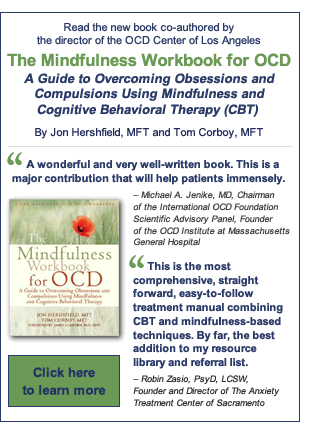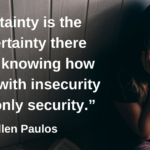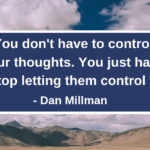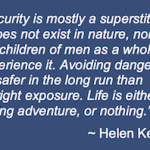
problem for many struggling with OCD.
Virtually everybody experiences unwanted thoughts from time to time, for we human beings are not always in charge of what we think. But for sufferers of Obsessive Compulsive Disorder (especially Pure Obsessional OCD), the problem is not just the presence of unwanted thoughts, but also the attention and meaning one gives to them.
OCD and Thought-Action Fusion
Obsessive Compulsive Disorder (OCD) not only produces constant mental noise and endless worry, but also often includes a cognitive process known as thought-action-fusion. The distorted thought at the heart of thought-action-fusion is the irrational assumption that just because a “bad” thought presents itself to your mind, then it is undeniably followed or accompanied by a specific “bad” action. For some, this fusion is so strong that they believe that their thoughts actually cause actions to occur. Clients who suffer from thought-action fusion often report intense fear because of their belief that their thoughts will come true. Thought-action fusion is particularly common in the Pure O variant that is colloquially known as Harm OCD. For example, a teenage girl may worry that if she has a thought of a home invasion happening to her family, then the break-in will undoubtedly occur. Or a college student might fear that he will wander out of his dorm room and harm someone without knowing it. If this student is struggling with Harm OCD complicated by thought-action fusion, he might be overcome with a debilitating belief that, because he thinks this thought, then he is almost certainly a sociopath and is likely to act on it.
In an attempt to prevent harm to themselves or loved ones, those with thought-action fusion often take on the weight of the world and compulsively attempt to be prepared for impending doom. The girl who fears the home invasion avoids spending the night out with her friends, and repeatedly does compulsive rituals in an effort to protect her family from attack. She dreads the day she leaves for college, as she will be removed from the “guard station” she operates from her childhood bedroom. The college student who fears wandering out of his dorm room in the middle of the night begs his roommate to lock him in from the outside so that there is no risk that he will get out and harm someone.
When treating clients with these sorts of obsessions, I often suggest an analogy in which I liken their thoughts and actions to those of a person who anxiously sits on their living room sofa with a fire extinguisher waiting for a fire that may someday occur. The analogy focuses on the obsessive need of the fearful individual to not only prevent a fire, but to also be prepared at all times to protect him/herself and loved ones from the potential threat of a fire. But the simple fact of the matter is that life is a risk. We cannot be prepared 100% of the time to prevent and protect ourselves and others from tragedy. There must be a willingness to take a chance and recognize that if and/or when there is a fire, that your response will be the same whether or not you have been awaiting its arrival. For clients with OCD and anxiety, a primary goal of treatment is to get up off the “couch” and embrace the possibilities, and risks, of life. Of course, this is easier said than done.
Treatment for OCD and Thought-Action Fusion
For those with OCD complicated by thought-action fusion, treatment proceeds through a structured series of steps in order to gain the insight and courage to challenge their irrational thoughts and compulsive behaviors. Cognitive Behavioral Therapy (CBT) for OCD and anxiety is a multi-modal approach which begins with focusing on the thought process itself. Using a technique called “cognitive restructuring”, clients learn to recognize their irrational thoughts, and to challenge the “bully” in their brains. They learn to respond to an irrational thought (i.e., “I may wander out and hurt someone”) with a more rational and evidence-based thought (i.e., “I have had this thought many times, and never once have I wandered out and hurt someone”).
Mindfulness Based CBT for Thought Action Fusion
When clients can begin to effectively recognize their distorted thinking and to more actively challenge their internal mental bully, therapy proceeds to what is known as Mindfulness-Based CBT. A simple way of describing mindfulness for OCD is that it is learning the skill of non-judgmental awareness and acceptance of one’s thoughts and feelings. Using mindfulness, one learns to focus not on changing or eliminating unwanted thoughts and feelings, but rather on fully accepting their existence. After all, the thoughts and feelings are there, whether we like it or not! The ultimate goal of mindfulness for OCD and anxiety is for clients to develop their ability to fully accept the presence of their unwanted thoughts, and to recognize that just because they have these thoughts does not imply that they have meaning. A thought is not “good” or “bad”, it just “is”. In practicing mindfulness, clients  work on changing their perspective towards the unwanted thoughts that plague their mind, and in turn, changing their cognitive and behavioral reaction to them.
work on changing their perspective towards the unwanted thoughts that plague their mind, and in turn, changing their cognitive and behavioral reaction to them.
Exposure and Response Prevention for Thought Action Fusion
When clients begin to develop the ability to truly accept their unwanted thoughts, and to recognize that these thoughts do not automatically have meaning, treatment turns to the behavioral part of CBT, which is known as “Exposure and Response Prevention” (ERP). The goal of ERP is straightforward – to expose one’s self to the feared thought or situation, without doing any compulsive or avoidant responses.
But ERP for obsessive thoughts and mental rituals is a bit different from ERP for more compulsive variants of OCD such as compulsive hand washing or door checking. Behavioral exposures for the more obsessional forms of OCD often include intentionally thinking unwanted thoughts rather than avoiding them or trying to make them go away. Not only are these unwanted thoughts purposely experienced, but short stories are created for use as imaginal exposures. For example, the girl who fears a break-in at her family home will write a short exposure story which focuses on her fear that an intruder would break in and harm her family. By writing these stories, and then reading them repeatedly, clients desensitize to the content, becoming markedly less afraid of thoughts which previously terrified them. Because of the nature of these exposure stories, this process can be quite difficult and painful for the client. But using imaginal exposures helps clients to learn four valuable lessons about their fearful thoughts:
1) When they purposely think their fearful thoughts, the feared event almost never occurs.
2) The anxiety related to their unwanted thoughts almost always decreases significantly.
3) Even if a feared event does as some point coincidentally happen to occur (i.e., sometimes homes do get broken into), it is unlikely to be as catastrophic as feared (i.e., most break-ins are committed for money, and only very rarely result in murder).
4) They are quite capable of tolerating the unwanted thoughts and uncomfortable feelings that they have avoided for so long.
In attempting to suppress a fearful thought, and avoiding specific situations as a result, the thought is only perpetuated and intensified. Conversely, it is not until the thought is faced head-on that it begins to subside. ERP is standing up to the bully that hunts for you on the playground. Rather than continuing compulsive and avoidant behaviors, and experiencing endless fear and anxiety, you confront the bully and put the bullying to a stop. In intentionally thinking a fearful thought, one is saying “I’m not afraid of you! In fact, I’m coming to find you!”. The girl who avoids leaving the house is now able to sleep over at a friend’s home, and the college student stops asking his roommate to lock him in their dorm room. At first, they may be fearful that there will be an intruder, or that they might wander out and harm someone, but as time passes, they learn that constantly protecting themselves and others from harm is not necessary. Each morning when they wake up, they find themselves and others safe and become more willing to embrace the risks of life. They no longer need to sit on the sofa waiting for a fire to start.
•Laura Yocum, MFT, is a licensed psychotherapist at the the OCD Center of Los Angeles, a private, outpatient clinic specializing in Cognitive-Behavioral Therapy (CBT) for the treatment of Obsessive-Compulsive Disorder (OCD) and related conditions. In addition to individual therapy, the center offers six weekly therapy groups, as well as online therapy, telephone therapy, and intensive outpatient treatment. To contact the OCD Center of Los Angeles, click here.





























































27 Comments
Very well written – as if it is a step wise treatment of pure O having “Thought Action Fusion”. I’d like to ask you one question. Normally it is said that someone with pure O need not read articles on the web as it is treated as a compulsive action for finding a solution to his or her problem. If it is, then how does one get knowledge to know what is the ailment and how to manage it or get cured at all. Please elaborate and reply to my basic question of reading web articles like yours by those having pure O.
Most definitely what I suffer from is ocd with thought action fusion. This really hit home to where I am in mindfulness based cbt/dbt now. I do need to have the Dr and group component. I think this article really is explained and written well. Thank you.
I really found this article helpful. Thank you for your comprehensive, easy-to-understand explanation of thought-action fusion and its treatment.
Hello Susheel,
I am pleased you found the article informative and helpful.
You ask a valid question regarding how much web research is too much when dealing with OCD. It is true that researching articles online may become a compulsive action. This however, does not mean that all research is compulsive.
The best way to distinguish between legitimate educational researching and compulsive researching is to ask yourself this simple question – “will I be anxious if I do not do the research?”. If the answer is yes, it is most likely compulsive. Also, try limiting your researching to a specific, reasonable amount of time daily, or limiting the number of resources you allow yourself to locate and read (30 minutes, or 1-3 resources every other day seems reasonable). I hope this answers your question.
Hi Janet,
Thank you for your gracious comment. Feedback is always critical and appreciated.
Thank you for this wonderful article. I have OCD and received this type of behavioral therapy from the OCD Center of LA in 2002. I’m going on 11 years without any OCD episodes. This therapy is priceless because it teaches your brain to think differently. I highly recommend this to anyone who is experiencing these types of intrusive ruminations. The article is a valuable resource to those of us who continue to exercise their brain to think differently. I don’t assume that I will never have another OCD episode, I just know that when/if I do, I’m ready for it. Thanks again.
This is very helpful thank you. My partner suffers from this problem and has previously had CBT but was unsuccessful. To get around the exposure therapy she just argues that just because the bad thing hasn’t happened now it may do at any time in the future. How do you get around that logic? Is it common?
Hi Michelle,
I am so glad you found value in the article and in the treatment. Often, individuals suffering with these types of intrusive thoughts are left dealing with shame, guilt, and feelings of hopelessness. The treatment offers education, insight, and tools to move towards overcoming the fear tied into this type of thinking, and provides a new found sense of peace of mind.
Hi Dave,
Although CBT is often quite successful, there are cases where the client is unwilling or unable to follow through. The treatment can be challenging, and in the short term may provoke increased amounts of anxiety in the process of “getting better.” Typically, a client must be motivated to end his/her own suffering despite the fear that sometimes accompanies the treatment.
It is common that people with this type of condition try to rationalize their way out of the feared thought. The rationalization is the compulsion itself. The obsessive-compulsive cycle begins with some sort of intrusive, disturbing thought, then the individual experiences varying amounts of anxiety as a result. In order to “get out” of the unwanted feeling state (anxiety, terror, fear, guilt) the individual is motivated to do something and that something is the compulsion.
In the case of your partner, it seems that the “doing” part is the denying of the possibility that something bad could happen. It is crucial in treating thought-action-fusion that the client gradually eliminate the compulsive behavior (both mental and physical rituals) and move towards a place of acceptance that we can not be certain about anything.
Bad things can happen, and the sooner your partner can embrace that idea, the faster the anxious responses to feared thoughts will decrease. So, when an obsession (typically a “what if” thought) arises, rather than rationalizing in an attempt to reach a point of certain safety, encourage your partner to embrace the idea that “we cannot predict the future” or “we just don’t know.” There may be increased anxiety at first, but evidence shows that over time it will begin to decrease.
That’s a really great article!
Can I ask, in my case I suffer from intrusive thoughts (some minor compulsions but they’re manageble). I have the thoughts constantly, I don’t believe anything bad will happen or that I will do anything wrong, it is the content of the thought that makes me feel horrible and fills me with dread, disgust, guilt and anxiety. How do I overcome this when there isn’t a compulsion involved?
Thankyou
Hi Amy,
Great question! It’s important to note that many, many people with obsessional forms of OCD do not exhibit thought-action fusion. For example, many with unwanted thoughts related to sexuality and/or harm have intrusive thoughts, but do not then jump to the concern that a specific action will occur.
As for overcoming these thoughts, research has consistently found that the best treatment for all forms of OCD is Cognitive Behavioral Therapy (CBT), which addresses not just the obvious compulsions, but the mental compulsions seen in so many people with obsessional forms of OCD. You may want to check out our article on “mental checking” at https://ocdla.com/ocd-mental-checking-1947/.
Great article- it gives me some reassurance that maybe i can get better. I have terrible relationship thoughts – that i don’t love/like/want to be with my partner. I get heavily stressed about the thoughts and doubts i have about it and it causes me to react to things negatively that she may say or do – which in turn i treat as a sign of not loving her etc.
I have always been like this with anyone i care about and i know i wouldn’t be any different if i left her and met someone else – i’d do that same thing- if i think about leaving i feel like i would feel better but that i guess is just that i would be leaving the OCD behind me – the issue would be irrelevant now – is this a common trait of pure O? And do you think CBT or MBSR would be a better bet for me.
Hi David,
Thank you for your comment.
The symptoms you describe sound like a common sub-type of OCD called “Relationship OCD”, or ROCD. Remember that OCD has often been called “the doubting disease”, because of the strong obsessional focus on doubt. People with OCD can have obsessional doubt about anything, and this doubt usually focuses on issues that are important to the person. In your case, that means doubting the veracity of your feelings for your partner.
A good CBT therapist would include a focus on mindfulness, including concepts that are quite similar to those of MBSR (Mindfulness Based Stress Reduction). In fact, we describe our program at the OCD Center of Los Angeles as “Mindfulness Based CBT for OCD“.
I encourage you to read our article on ““Mindfulness for OCD and Anxiety”“.
Helloi find this to be a great read, i have been suffering from anxiety for two months GAD but its fading one thing that i have been getting is extreme Intrusive thoughts about killing my self, like images of me blowing my brains out or : what if i get drunk and kill my self” or what if on my camping trip and overdose on my medicine” an it scares me so much and i start dwelling on that thought thinking about it getting so scared but that is so out of character for me i never ever had those type of those and i know i do the thought action fusion i didnt have those thoughts for a week and was feeling great lingering anxiety but that thought was gone. but i had it again last night and dwelled and had anxiety and really scared me. if you have any advice please help.
I’ve had OCD since I was a child, long before I ever had a clue that there was such a thing. I am now 64 years old. I had some therapy, which worked really well and took some meds. I thought that I was forever rid of this horrible thing called OCD when we moved back to the US from Germany and I stopped seeing my therapist and psychiatrist, but OCD is unpredictable. Now something came up that actually goes back 41 years and never came up during my time in therapy. During one of my bouts with OCD I had a spontaneous thought that I wanted my sister to get bladder cancer. I have no idea where that thought came from. I had so many other issues at the time that the thought got buried under other problems, but guess what, on a recent visit to Germany to see my sister she told me she had bladder pain and I almost freaked out. She did have her bladder checked and it is okay, but now I cannot think of anything else but that she will get bladder cancer sometime in the future. I don’t know how to deal with this. I’m so depressed and stressed out I feel like I will lose my mind. Any advice would be greatly appreciated. I keep thinking back on the thought and trying to remember exactly how it felt and where it came from but it is hard to go back to a thought that happened 41 years ago.
My fear is that I will cause something to happen to myself or someone I love by making deals to God or the devil and breaking them. Is this OCD/scrupulosity? It starts with an accidental deal and then I get so worried about it, I end up purposely making another deal to keep the previous deal from happening. My fear is that God will hold me to (and cause the bad thing I asked him not to let happen) happen if I break the deal. Should I face my fears and break these deals or not?
JK,
The “deals” you describe sound very much like Scrupulosity combined with Harm OCD, which is a common combination in OCD. Thought-Action Fusion occurs in many variants of OCD, especially the more obsession variants such as Scrupulosity and Harm OCD. And yes, you should “break these deals”, which are nothing more than compulsions done in an irrational attempt to avoid anxiety about causing bad things from happening.
I don’t know if what I experience is thought action fusion and I’d like your opinion on it.
Basically, when I get a bad thought (mostly of the harm type, but it can also be other things) then I fear having done the associated action. Example: I am changing my daughter’s diaper, I get a bad thought about touching her intimate parts, and I am afraid I have really done it.
Or I see a mushroom that resembles a deadly one, I think I must not touch it, I get the image of myself touching it, and I fear having done it. And I then run to wash my hands.
I have never seen these symptoms in books, but I know others have similar ones. Does it sound like thought-action fusion to you?
Dave,
As the article notes:
“Thought-action-fusion is the irrational assumption that just because a “bad” thought presents itself to your mind, then it is undeniably followed or accompanied by a specific “bad” action. For some, this fusion is so strong that they believe that their thoughts actually cause actions to occur.”
I see no evidence of thought-action fusion in your comment here. What I do see are examples of obsessions commonly experienced by those with OCD.
Dear Tom,
I thought I had replied to this but I do not see my reply.
Thank you for answer. I still have a question though. What should I call my symptoms then if not thought action fusion?
The main point is that I have a thought and I fear it corresponded to an action. I see a red spot on the sink, I think it may be blood. I think that I may lick it, and I have the impression that I have really licked it. Sometimes I have a doubt on whether I really did it. Sometimes, I can clearly say “it was a thought” but the anxiety still spikes and if I am very anxious I often end up doing the compulsion even in the latter case.
I know I need to cut down on compulsions, but it’s easier said than done ;).
Dave,
Why do you need to call your symptoms anything? It sounds to me like you are trying to come up with something about your symptoms that makes them “special” or “important”.
If you insist on calling them something, call them “thoughts”.
My OCD is religious I had a doubtful thought pop into my head about Jesus and was afraid I was really doubting so did rituals to dispel that fear then read about unpardonable sin and try to avoid doing that. Afraid I will be the one person that will do that albeit against my will. Fear doing that. Now I am in ERP doing blasphemous thought therapy. Is it ok to say
Before I do ERP. These are thoughts I don’t like? Exposing myself to them? was the doubtful thought episode and the unpardonable sin fear an example of thought action fusion? How do I separate the thought fusion from the ERP
I am doing?
Susie,
When you ask if it is ok to do what our ERP therapist is telling you would be a good exposure, I am pretty sure you are looking for reassurance, which in itself is a compulsion. So if I were to answer your question about this, I would be doing the exact wrong thing.
I encourage you to read our article “Reassurance Seeking in OCD and Anxiety”. I also encourage you to read our series of articles on Scrupulosity OCD, starting at https://ocdla.com/scrupulosity-ocd-religion-faith-belief-2107/.
I started with intense intrusive thoughts about my partner, whether I loved her and this was very distressing as she is my world. Now I am plagued with intrusive thoughts of racial slurs and I’m crippled with the fear of being capable of being racist or thinking racist. never in my life have I been racist, but all of a sudden racial slurs appear in my head and they make me sick. I even fear I may say out loud and be racist to my partner and she will leave. Is this a real thing? It’s Almost like it attacks the things most important to me.
Barbara,
Your obsessions about not loving your partner sound very much like Relationship OCD, aka ROCD. I encourage you to read our article on ROCD at https://ocdla.com/rocd-relationship-ocd-myth-of-the-one-3665/.
Your obsessions about being a racist are fairly common in OCD. These obsessions are essentially a form of Moral Scrupulosity and Harm OCD in which the sufferer fears harming someone with their use of language that is hurtful. And as you note, OCD often “attacks the things most important to” the sufferer.
Thank you so much for your reply, I was beginning to doubt that these may have underlying meanings and my worst fears Have come true. I am working on acceptance and looking into rationalizing. I am also working on an exposure story where I read over the worst case scenario, would this be helpful in overcoming these intrusive thoughts?
Barbara,
Exposure stories can be extremely helpful for addressing the types of obsessions you mention, but they should be developed and implemented under the guidance of a therapist who specializes in treating OCD. That said, you can read our article about imaginal exposure scripting at https://ocdla.com/imaginal-exposure-ocd-anxiety-4847/.